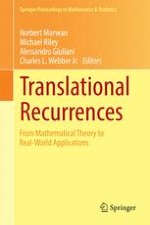This book features 13 papers presented at the Fifth International Symposium on Recurrence Plots, held August 2013 in Chicago, IL. It examines recent applications and developments in recurrence plots and recurrence quantification analysis (RQA) with special emphasis on biological and cognitive systems and the analysis of coupled systems using cross-recurrence methods.
Readers will discover new applications and insights into a range of systems provided by recurrence plot analysis and new theoretical and mathematical developments in recurrence plots. Recurrence plot based analysis is a powerful tool that operates on real-world complex systems that are nonlinear, non-stationary, noisy, of any statistical distribution, free of any particular model type and not particularly long. Quantitative analyses promote the detection of system state changes, synchronized dynamical regimes or classification of system states.
The book will be of interest to an interdisciplinary audience of recurrence plot users and researchers interested in time series analysis of complex systems in general.
